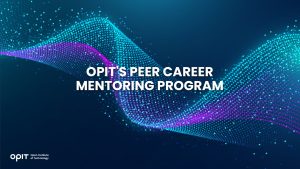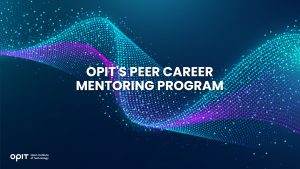

Quality of faculty: that’s what compelled Matthew Belcher, an independent freelance web developer and student working towards a Bachelor in Computer Science, to enroll in the Open Institute of Technology (OPIT), allowing him to work with some of the top professionals in his chosen industry.
Matthew was recently elected program representative for the course, helping to guide the interests of over 100 students across the globe in discussions with the area chair and director to ensure that the course is fit for purpose and meets student needs.
Why OPIT?
In a recent interview, Matthew told us that the reason he chose OPIT to continue his education was the expertise of the faculty. He shared that he conducted intensive research into a variety of programs that would help him shape his interest and skill in technology into potential career opportunities.
Matthew felt that the OPIT faculty stood out as not just great teachers, but top-tier professionals with real-world experience in the kinds of industries he wants to work in. Their professional roles mean they offer an up-to-the-minute understanding of the changing market.
The Computer Science Program
The BSc in Computer Science is a fully accredited course delivered completely online over six 13-week terms.
The program delivers foundational skills, both theoretical and practical, in all aspects of computer science, including programming, software development, databases, cloud computing, cybersecurity, data science, and artificial intelligence. Students deliver a dissertation or project in the final term, and in term five, they can choose five electives from a pool of 27, or choose to specialize in one of five fields:
- Data Science and Artificial Intelligence
- Cloud Computing
- Cybersecurity
- Metaverse and Gaming
- Full Stack Development
The BSc in Computer Science is aimed at students interested in software development and engineering, data science, web development, app and game development, IT business analysis, cybersecurity, and database architecture.
Meet the Faculty
Now let’s meet some of the incredible faculty who influenced Matthew’s decision to select OPIT.
Art Sedighi
As well as teaching at OPIT, Art Sedighi is an adjunct professor at Johns Hopkins University and a professor at Purdue University Global. He was previously a partner at CDI Global, a senior cybersecurity solution architect at Amazon AWS, and head of high-performance computing and grid engineering at the Bank of America.
Sedighi has 20 years of experience planning, designing, developing, and having end-to-end ownership of cloud solutions. He has managed cross-functional teams and been responsible for driving adoption strategies across enterprises.
Sedighi teaches software engineering and cloud adoption in the BSc in Computer Science and is also a professor in the BSc in Digital Business program.
Lokesh Vij
As well as teaching in OPIT’s Computer Science Program, Lokesh is a database architect at Broadcom Inc., a semiconductor manufacturing firm in Canada, and a part-time professor at Seneca Polytechnic in Toronto.
Vij describes himself as a cloud and data evangelist, educator, and mentor. With over 20 years of rich experience, he has designed, developed, and delivered enterprise-scale data solutions across disparate source systems, data formats, and relational and non-relational databases.
His proven expertise includes enhancing business profitability by leveraging insights derived from diverse data sets, constructing decision support systems that convert transactional data into analytical formats. This, combined with data visualization techniques, allows him to articulate and clarify business insights effectively.
In the BSc in Computer Science program, he teaches cloud computing infrastructure, cloud development, cloud computing automation and ops, and cloud data stacks. He is also a professor of the BSc in Digital Business and the MSc in Applied Data Science & AI, also covering big data and cloud computing.
Tom Vazdar
Tom Vazdar is OPIT’s area chair for cybersecurity and also the CEO of Riskoria, which focuses on cybersecurity strategies. His areas of expertise include strategy services, AI and cybersecurity, AI infrastructure development, and compliance assurance and risk management.
Vazdar teaches computer security in both the BSc in Computer Science and the BSc in Digital Business programs, as well as for the MSc in Enterprise Cybersecurity.
Sylvester Kaczmarek
Sylvester Kaczmarek is a former Chief Science Officer at WeSpace Technologies and a former AI Mentor and Researcher at NASA. He is now an independent executive leading secure, safe, and resilient AI-driven space innovations, a science communicator, and an advisor to deep tech investors, governments, and startups.
In the past, he has specialized in the integration of artificial intelligence, robotics, cybersecurity, and edge computing in aerospace applications.
In OPIT’s BSc in Computer Science program, Kaczmarek teaches cartography and secure communications, secure software development, and parallel and distributed computing. He also teaches in the MSc in Enterprise Cybersecurity program.
Lorenzo Marvardi
As well as teaching at OPIT, Lorenzo Marvardi is a managing director at Accenture. With a background in cybersecurity management and security consulting, he has 15 years of experience as a security professional and executive, implementing security programs across different industries and geographies.
Marvardi teaches cybersecurity in both the BSc in Computer Science and the BSc in Digital Business programs.
Khaled Elbehiery
Khaled Elbehiery is a senior director and network engineer at Charter Communications. As well as teaching for OPIT, he is a part-time professor at Park University and DeVry University, both in the United States.
He describes himself as a professor, scientist, inventor, and author. He has publications on cloud engineering, quantum computing, space, robotics, bionics, microgravity, and modern educational methodologies.
Elbehiery teaches cloud and IoT security and computer networks on both the BSc in Computer Science and the MSc in Enterprise Cybersecurity programs.
Francesco Derchi
Francesco Derchi is a brand, innovation, and digital expert with over 14 years of experience. He is chair of digital business at OPIT, an advisory board member for Arsene Lippens, on the faculty at EHL in Switzerland and the Universita degli Studi di Genova, plus course director and contributor to the Harvard Business Review Italia.
Derchi teaches business strategy and digital marketing on both the BSc in Computer Science and the BSc in Digital Business, as well as on the MSc in Digital Business and Innovation.
Related posts

Source:
- Raconteur, published on November 06th, 2025
Many firms have conducted successful Artificial Intelligence (AI) pilot projects, but scaling them across departments and workflows remains a challenge. Inference costs, data silos, talent gaps and poor alignment with business strategy are just some of the issues that leave organisations trapped in pilot purgatory. This inability to scale successful experiments means AI’s potential for improving enterprise efficiency, decision-making and innovation isn’t fully realised. So what’s the solution?
Although it’s not a magic bullet, an AI operating model is really the foundation for scaling pilot projects up to enterprise-wide deployments. Essentially it’s a structured framework that defines how the organisation develops, deploys and governs AI. By bringing together infrastructure, data, people, and governance in a flexible and secure way, it ensures that AI delivers value at scale while remaining ethical and compliant.
“A successful AI proof-of-concept is like building a single race car that can go fast,” says Professor Yu Xiong, chair of business analytics at the UK-based Surrey Business School. “An efficient AI technology operations model, however, is the entire system – the processes, tools, and team structures – for continuously manufacturing, maintaining, and safely operating an entire fleet of cars.”
But while the importance of this framework is clear, how should enterprises establish and embed it?
“It begins with a clear strategy that defines objectives, desired outcomes, and measurable success criteria, such as model performance, bias detection, and regulatory compliance metrics,” says Professor Azadeh Haratiannezhadi, co-founder of generative AI company Taktify and professor of generative AI in cybersecurity at OPIT – the Open Institute of Technology.
Platforms, tools and MLOps pipelines that enable models to be deployed, monitored and scaled in a safe and efficient way are also essential in practical terms.
“Tools and infrastructure must also be selected with transparency, cost, and governance in mind,” says Efrain Ruh, continental chief technology officer for Europe at Digitate. “Crucially, organisations need to continuously monitor the evolving AI landscape and adapt their models to new capabilities and market offerings.”
An open approach
The most effective AI operating models are also founded on openness, interoperability and modularity. Open source platforms and tools provide greater control over data, deployment environments and costs, for example. These characteristics can help enterprises to avoid vendor lock-in, successfully align AI to business culture and values, and embed it safely into cross-department workflows.
“Modularity and platformisation…avoids building isolated ‘silos’ for each project,” explains professor Xiong. “Instead, it provides a shared, reusable ‘AI platform’ that integrates toolchains for data preparation, model training, deployment, monitoring, and retraining. This drastically improves efficiency and reduces the cost of redundant work.”
A strong data strategy is equally vital for ensuring high-quality performance and reducing bias. Ideally, the AI operating model should be cloud and LLM agnostic too.
“This allows organisations to coordinate and orchestrate AI agents from various sources, whether that’s internal or 3rd party,” says Babak Hodjat, global chief technology officer of AI at Cognizant. “The interoperability also means businesses can adopt an agile iterative process for AI projects that is guided by measuring efficiency, productivity, and quality gains, while guaranteeing trust and safety are built into all elements of design and implementation.”
A robust AI operating model should feature clear objectives for compliance, security and data privacy, as well as accountability structures. Richard Corbridge, chief information officer of Segro, advises organisations to: “Start small with well-scoped pilots that solve real pain points, then bake in repeatable patterns, data contracts, test harnesses, explainability checks and rollback plans, so learning can be scaled without multiplying risk. If you don’t codify how models are approved, deployed, monitored and retired, you won’t get past pilot purgatory.”
Of course, technology alone can’t drive successful AI adoption at scale: the right skills and culture are also essential for embedding AI across the enterprise.
“Multidisciplinary teams that combine technical expertise in AI, security, and governance with deep business knowledge create a foundation for sustainable adoption,” says Professor Haratiannezhadi. “Ongoing training ensures staff acquire advanced AI skills while understanding associated risks and responsibilities.”
Ultimately, an AI operating model is the playbook that enables an enterprise to use AI responsibly and effectively at scale. By drawing together governance, technological infrastructure, cultural change and open collaboration, it supports the shift from isolated experiments to the kind of sustainable AI capability that can drive competitive advantage.
In other words, it’s the foundation for turning ambition into reality, and finally escaping pilot purgatory for good.

The Open Institute of Technology (OPIT) is the perfect place for those looking to master the core skills and gain the fundamental knowledge they need to enter the exciting and dynamic environment of the tech industry. While OPIT’s various degrees and courses unlock the doors to numerous careers, students may not know exactly which line of work they wish to enter, or how, exactly, to take the next steps.
That’s why, as well as providing exceptional online education in fields like Responsible AI, Computer Science, and Digital Business, OPIT also offers an array of career-related services, like the Peer Career Mentoring Program. Designed to provide the expert advice and support students need, this program helps students and alumni gain inspiration and insight to map out their future careers.
Introducing the OPIT Peer Career Mentoring Program
As the name implies, OPIT’s Peer Career Mentoring Program is about connecting students and alumni with experienced peers to provide insights, guidance, and mentorship and support their next steps on both a personal and professional level.
It provides a highly supportive and empowering space in which current and former learners can receive career-related advice and guidance, harnessing the rich and varied experiences of the OPIT community to accelerate growth and development.
Meet the Mentors
Plenty of experienced, expert mentors have already signed up to play their part in the Peer Career Mentoring Program at OPIT. They include managers, analysts, researchers, and more, all ready and eager to share the benefits of their experience and their unique perspectives on the tech industry, careers in tech, and the educational experience at OPIT.
Examples include:
- Marco Lorenzi: Having graduated from the MSc in Applied Data Science and AI program at OPIT, Marco has since progressed to a role as a Prompt Engineer at RWS Group and is passionate about supporting younger learners as they take their first steps into the workforce or seek career evolution.
- Antonio Amendolagine: Antonio graduated from the OPIT MSc in Applied Data Science and AI and currently works as a Product Marketing and CRM Manager with MER MEC SpA, focusing on international B2B businesses. Like other mentors in the program, he enjoys helping students feel more confident about achieving their future aims.
- Asya Mantovani: Asya took the MSc in Responsible AI program at OPIT before taking the next steps in her career as a Software Engineer with Accenture, one of the largest IT companies in the world, and a trusted partner of the institute. With a firm belief in knowledge-sharing and mutual support, she’s eager to help students progress and succeed.
The Value of the Peer Mentoring Program
The OPIT Peer Career Mentoring Program is an invaluable source of support, inspiration, motivation, and guidance for the many students and graduates of OPIT who feel the need for a helping hand or guiding light to help them find the way or make the right decisions moving forward. It’s a program built around the sharing of wisdom, skills, and insights, designed to empower all who take part.
Every student is different. Some have very clear, fixed, and firm objectives in mind for their futures. Others may have a slightly more vague outline of where they want to go and what they want to do. Others live more in the moment, focusing purely on the here and now, but not thinking too far ahead. All of these different types of people may need guidance and support from time to time, and peer mentoring provides that.
This program is also just one of many ways in which OPIT bridges the gaps between learners around the world, creating a whole community of students and educators, linked together by their shared passions for technology and development. So, even though you may study remotely at OPIT, you never need to feel alone or isolated from your peers.
Additional Career Services Offered by OPIT
The Peer Career Mentoring Program is just one part of the larger array of career services that students enjoy at the Open Institute of Technology.
- Career Coaching and Support: Students can schedule one-to-one sessions with the institute’s experts to receive insightful feedback, flexibly customized to their exact needs and situation. They can request resume audits, hone their interview skills, and develop action plans for the future, all with the help of experienced, expert coaches.
- Resource Hub: Maybe you need help differentiating between various career paths, or seeing where your degree might take you. Or you need a bit of assistance in handling the challenges of the job-hunting process. Either way, the OPIT Resource Hub contains the in-depth guides you need to get ahead and gain practical skills to confidently move forward.
- Career Events: Regularly, OPIT hosts online career event sessions with industry experts and leaders as guest speakers about the topics that most interest today’s tech students and graduates. You can join workshops to sharpen your skills and become a better prospect in the job market, or just listen to the lessons and insights of the pros.
- Internship Opportunities: There are few better ways to begin your professional journey than an internship at a top-tier company. OPIT unlocks the doors to numerous internship roles with trusted institute partners, as well as additional professional and project opportunities where you can get hands-on work experience at a high level.
In addition to the above, OPIT also teams up with an array of leading organizations around the world, including some of the biggest names, including AWS, Accenture, and Hype. Through this network of trust, OPIT facilitates students’ steps into the world of work.
Start Your Study Journey Today
As well as the Peer Career Mentoring Program, OPIT provides numerous other exciting advantages for those who enroll, including progressive assessments, round-the-clock support, affordable rates, and a team of international professors from top universities with real-world experience in technology. In short, it’s the perfect place to push forward and get the knowledge you need to succeed.
So, if you’re eager to become a tech leader of tomorrow, learn more about OPIT today.
Have questions?
Visit our FAQ page or get in touch with us!
Write us at +39 335 576 0263
Get in touch at hello@opit.com
Talk to one of our Study Advisors
We are international
We can speak in:


